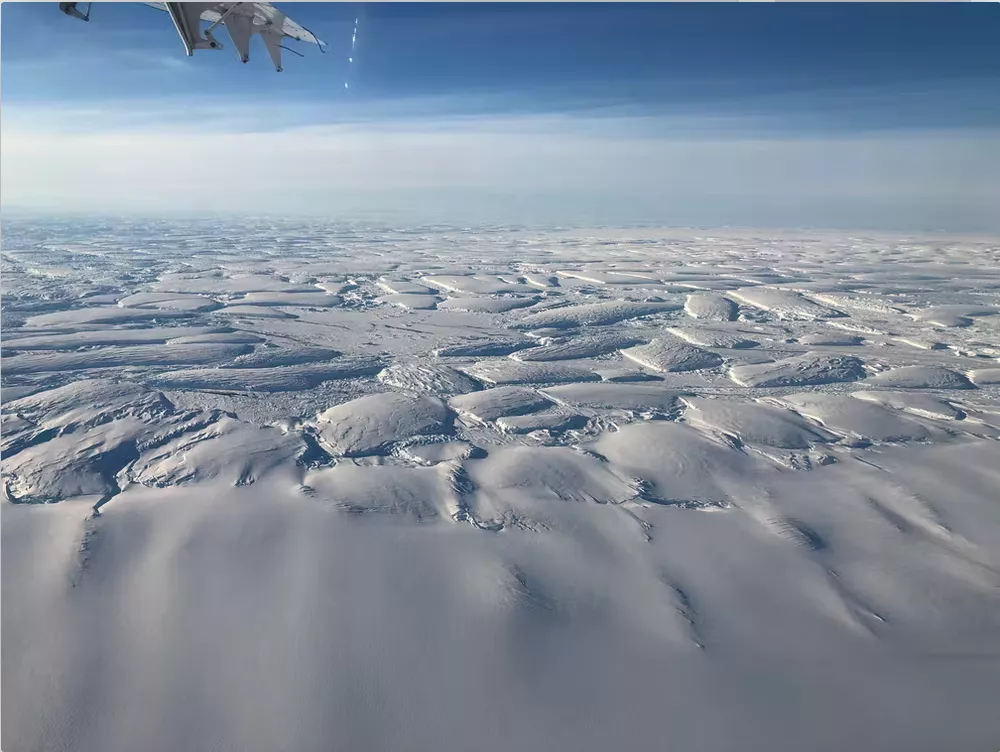In March 2006, a US-Argentine team landed on two icebergs that had broken off from a massive glacier-fed ice shelf on the Antarctic Peninsula. The team, which included two NSIDC researchers, installed a battery of science instruments on both icebergs. The team then monitored the icebergs over the next several months. Researchers observed how the icebergs disintegrated as they drifted northward into a warmer climate, relying on readings transmitted by the instruments and on satellite imagery.
The icebergs’ northward trek inspired the project’s name: IceTrek. IceTrek’s aim was to better understand how climate change might induce ice shelf disintegration and consequently contribute to higher sea level.
Why icebergs make good proxies
The world’s biggest ice shelves are fed by glaciers, and act as emergency brakes for those glaciers. After the disintegration of the Larsen B Ice Shelf in 2002, the glaciers feeding the remnants of the Larsen Ice Shelf accelerated, moving toward the ocean several times faster than their previous flow speed. While an ice shelf disintegration by itself does not raise ocean level, a glacier flowing in the ocean does. Although glaciers on the Antarctic Peninsula contain only enough ice to raise ocean level by a few centimeters, glaciers draining the other parts of the Antarctic Ice Sheet have the potential to raise ocean levels substantially.
So far, observed ice shelf disintegration events have been rare. While that is good news for people living in coastal areas, the rarity of these events has left scientists with limited information about the breakup process. IceTrek scientists realized that studying disintegrating icebergs that calved off glacier-fed ice shelves is the next-best option. Icebergs calved from the largest ice shelves are large, flat plates of floating ice, just like the shelves. As they drift northwards towards warmer climates and ocean conditions, they undergo a “fast-forward” version of climate change, experiencing in a few weeks what might require a decade of warming conditions in Antarctica to achieve.
IceTrek funding and participation
The US National Science Foundation Office of Polar Programs funded the research. The Dirección Nacional del Antártico - Instituto Antártico Argentino provided logistical support and science guidance.
IceTrek team members brought a range of expertise to the fieldwork. Glaciologists Ted Scambos (University of Colorado) and Pedro Skvarca (Instituto Antartico Argentino) conducted traverse measurements of ice thickness and ice deformation across the iceberg during the team’s stay. Jonathan Thom (University of Wisconsin) and Ron Ross (Stanford University) handled deployment of automated weather stations, video, Iridium phone connections, and computer systems. Rob Bauer (University of Colorado) watched over the team's safety and performed radar profiling. Juan Carlos Quinteros helped with snowmobiles and other equipment.
Planning, fieldwork, and monitoring
The IceTrek team reached both icebergs by helicopter, landing on uk211 (renamed by the team AMIGOSberg) and A22A. The researchers set up Global Positioning System (GPS) instruments, cameras, weather instruments, and a radio-echo-sounder, which could measure ice thickness. Fieldwork proceeded quickly and efficiently thanks to several months of planning. Long before reaching the icebergs, Scambos, Bauer, and other NSIDC personnel built the instruments and tested their readings in the NSIDC parking lot.
Scambos provided regular updates on the fieldwork and the research results in a temporary IceTrek blog.
The intense bout of fieldwork was only the beginning of the research. The truly valuable information came in the succeeding months as the team monitored the icebergs’ journeys. Both icebergs headed into warmer waters, and both lasted until November 2006. After November 7, AMIGOSberg began to rapidly disintegrate. Warm slush and possible surface fractures toppled the AMIGOSberg station a few days later, although it continued transmitting until November 21, 2006.
A22A survived for several more months, shrinking gradually by the edge wasting process, but never reaching the rapid disintegration state that AMIGOSberg did. Researchers finally lost track of A22A in January 2007. By August 2007, A22A had shrunk so much that the IceTrek team could no longer track it by satellite.
IceTrek impact
In reflecting on the IceTrek, Scambos wrote:
Watching AMIGOSberg and A22A break up provided us with a model of how ice shelves, large plates of ice still attached to the Antarctic continent, can collapse. Like ice shelves, icebergs float on the ocean surface, but unlike the ice shelves, they are free to roam. As they drift from the poles into warmer water, they essentially undergo rapid climate change. Following the icebergs, and watching how they evolve in various climates, can tell us a lot about ice shelves might respond to a warming environment. . . . Knowing that a breakup may be on the way is important. If we know that the shelves are near the point of collapse, we can predict what will happen to the glaciers surrounding the shelf, and therefore, how sea level will change.
Published research results
Scambos, T., Ross, R., Bauer, R., Yermolin, Y., Skvarca, P., Long, D., . . . Haran, T. (2008). Calving and ice-shelf break-up processes investigated by proxy: Antarctic tabular iceberg evolution during northward drift. Journal of Glaciology, 54(187), 579-591. doi:10.3189/002214308786570836 (Cited by 46 studies as of Mar-27-2023)
Scambos, T., Ross, R., Haran, T., Bauer, R., Ainley, D., Seo, K., . . . MacAyeal, D. (2013). A camera and multisensor automated station design for polar physical and biological systems monitoring: AMIGOS. Journal of Glaciology, 59(214), 303-314. doi:10.3189/2013JoG12J170 (Cited by 8 studies as of Mar-27-2023)
Renfrow, S. J., R. Bauer, F. Fetterer, W. Meier, T. Scambos, M. Serreze, J. Stroeve. 2006. American Geophysical Union, Fall Meeting 2006, abstract id. U43D-05



